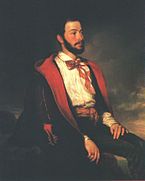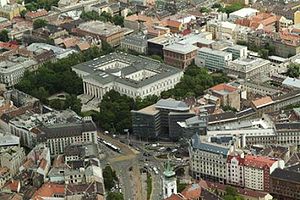- Hungarian National Museum
-
Contents
History
The Hungarian National Museum is said to have been founded in 1802 when Count Ferenc Széchényi set up the National Széchényi Library. This would then be followed a year later by the donating of a mineral collection by Széchényi’s wife. This led to the creation of the Hungarian National Museum as being a natural history museum, and not only a library. In 1807 the Hungarian National Parliament passed legislation on the new institution and asked the nation to help donate to the museum.
The Hungarian Parliament of 1832- 1834 helped with the growth of the museum as well. This parliament voted in favor of giving half a million forint to help with the construction of a new building for the museum. During this time the Hungarian National History Museum was officially set up under the Hungarian National Museum. Later in 1846, the museum moved to its current location of VIII. Múzeum krt. 14-16. Here the museum resides in a neo-classical style building designed by Mihály Pollack.
In 1848 the Hungarian National Museum played a major role in the Hungarian Revolution. The Revolution was partially spurred by the reading of Sándor Petőfi’s 12 points and the famous poem Nemzeti dal on the front steps of the museum. This helped give the museum an identification as a major national identity for Hungary. In remembrance of the revolution two statues were added to the museum. The first is a statue of János Arany which was unveiled in 1883. Later in 1890 there was a statue next to the stairs of the museum of a memorial tablet to Sándor Petőfi. In addition during this time the Upper House of the parliament held its sessions in the Cereminial of the museum. This continued until the new house of Parliament was built. Today in remembrance festivities for National Commemorations Day of 1848 are held in front of the museum.
In 1949 an act mandated that the ethnographic and natural history part of the Hungarian National Museum had to split off of the main museum. This also helped with the setting up of the modern day National Széchényi Library. All of these separate museums are still interconnected and other museums and monuments have become affiliated with them over time. The most recent addition was the Castle Museum in Esztergom that joined in 1985.
The Building
The building where the Hungarian National Museum is currently located was built from 1837-1847. The style of the main building was laid out in a neo-classical style and was added onto by other artists in the form of statues, paintings and other architecture. The statues of the Portico were done by Raffael Monti of Milan. One of these is a famous statue of the allegoric figure of Hungary, holding a shield with the Hungarian coat of arms on it. On the sides of this figure there is Science on one and Art on the other. In addition the paintings that have been in the staircase and on the ceiling since 1875 were done by Károly Lotz and Mór Than. There has also been a garden that is used primarily for various concerts. Various artists have performed here including Ferenc Liszt. Today the garden is the venue of the Museum Festival.
Exhibitions
The Hungarian National Museum has seven permanent displays. The History of Hungary from the foundation of the state to 1990 Middle Ages is the first one that is mentioned. This display covers topics such as the age of the Arpads, the Turkish Age, Transylvania and the royal Hungary, etc.
The Museum also covers Modern and Contemporary History. The history section here begins with the Rákóczi War of Independence, in the display it shows different sections of his military attire and various coins. The history section then ends with the rise and fall of the communist system in Hungary where the various politics are looked at. In another hall on the second floor one can find out about the Scholar Hungarians who made the twentieth century.
On one side of the first floor there is the exhibit: On the East-West frontier: History of the people of the Hungarian lands from 400,000 BC to 804 AD. This section then goes to look at various time periods between the Paleolithic period and the Avars. On the other side of the first floor is the Hungarian coronation mantle.
The ground floor’s permanent exhibit is focused on Medieval and Early Modern Lapidary. This exhibit looks at various stone relics and the carvings that have been made into them. The majority of the items in this collection were discovered during the 60’s and 70’s since they looked for more relics post World War II.
The final permanent exhibit is placed in the basement of the museum. This is the Roman Lapidary exhibit, which is a collection of old roman stones. These are mainly inscribed and carved and have some reference to Hungarian history.
Museum Information
The museum is open from 10 am to 6 pm Tuesday through Sunday and is closed on Mondays.
The permanent exhibition is free of charge. Guided tours are offered.
Museum Address: 1088 Budapest, Múzeum krt. 14-16, Hungary
Museum Phone: (36-1) 338-2122, (36-1) 327-7749
See also
Sources
Hungarian art 
List of Hungarian painters List of Hungarian sculptors Hungarian National Gallery Museum of Fine Arts - Budapest Tourism Office
- Museum.hu, Homepage to the Hungarian Museums
- Museums in Budapest
- Hungarian National Museum
Categories:- National museums
- Museums in Hungary
- Landmarks in Hungary
Wikimedia Foundation. 2010.



